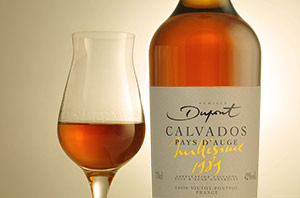Tasting Calvados
When and how do you taste it...?
Calvados should always be tasted at room temperature, preferably in a tulip shaped glass, or one which curves in at the top to concentrate its aromas.
• As an aperitif (young Calvados):
- neat, or with a little water or an ice cube
- in a cocktail: calvados is an excellent base for many cocktails, such as Green
Heart or the excellent Apple Mojito created by Marc Jean, Head-barman at the Hôtel Normandy Barrière in Deauville.
See
cocktail recipes containing Calvados >>
• During a meal (most often a young Calvados or one that is only slightly aged):
- to accompany marinated fish (very cold young calvados as one would use a vodka or aquavit)
- the "trou normand":
a ball of apple sorbet, not too sweet, doused with Calvados
- to accompany cheeses, especially those from Normandy
(such as Camembert or Livarot)
- to accompany desserts based on apple or chocolate.
No wine is wholly satisfactory as an accompaniment to apple desserts. Pommeau and Calvados make a perfect marriage for them.
• As a digestive (a well aged Calvados is best for this):
- on its own or with a square of dark chocolate or a cigar.
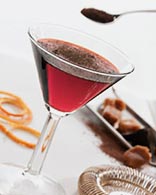
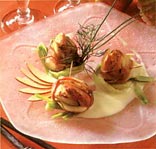
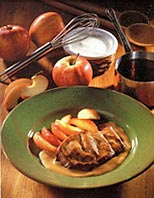 Calvados in cooking
Calvados in cooking
Flambéing with Calvados: To succeed in flambéing, it is important to warm the calvados gently in a small pan. Once it is hot light the Calvados in the pan and tip it carefully over the dish to be flambéd.
Deglazing with Calvados: When your foodstuff is cooked, tip the Calvados into the pan while it is still very hot, stirring/shaking to combine the Calvados with the cooking residues. Pour hot over the cooked food. Serve at once.
Recipe: Normandy style Trout for 4
4 trout, milk, flour, 1 walnut sized
knob of salted butter, 2 tablespoons
of Calvados, cream, salt, freshly
ground black pepper, a touch of freshly grated nutmeg, juice of 1
lemon.
Wash and gut the fish, before drying in a cloth. Dip into milk, roll in flour,
and cook in very hot butter in a frying pan. Then, when they are perfectly cooked,
flame with Calvados Add the cream, bubble it up for a moment or two to thicken
slightly, adding a touch of nutmeg. Add the lemon juice.
Calvados Tasting:
The eyes to observe the colour which evolves with age (from palest yellow in the youngest examples to a very deep mahogany for the oldest), the brilliance and the clarity. It is worth taking time to swirl it in the glass to admire all the glinting colour. In addition, the legs or tears on the sides of the glass are more numerous with age.
The nose for the aromas. The "first nose" consists of sniffing the glass without swirling the contents. The "second nose" consists of swirling the glass, to allow the action of oxygen to release all the nuances of aroma. Thus these aromas become more numerous and complex.
The mouth, finally, taking little sips, which you allow to pass all over the inside of the mouth. You can discern the balance between acidity and sweetness, the elegance or rustic character of its structure, the expression of the body at the middle and end of the mouthful, (after having swallowed it), and the integration of all these elements which creates the harmony of the whole.
The empty glass, once finished, develops aromas which, while generally less subtle, are just as interesting as those which showed when the calvados was first poured.
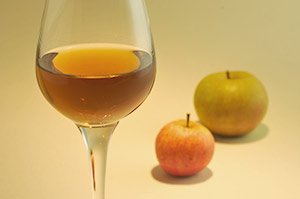
The evolution of the aromas of Calvados with age:
- Young Calvados:
- apple and pear, citrus, flowery hints, vanilla, toast...
- Moderately aged Calvados:
- apple and pear, citrus, dried apricot, vanilla, walnut, roasting coffee, chocolate, caramel, flowery hints...
- Very old Calvados:
- apples and pears, aromas of preserved fruits, walnuts, toasted hazelnuts, roasting coffee, chocolate, powerfully floral (rose and geranium) liquorice, undergrowth, leather...
